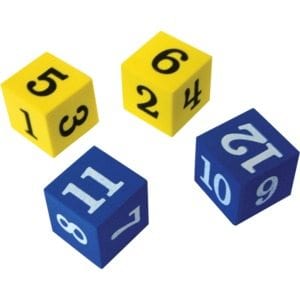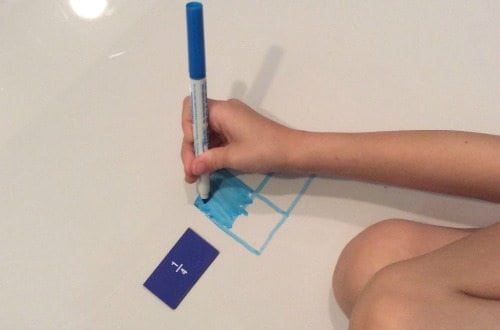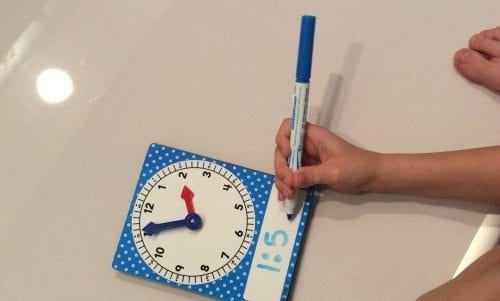Students learn better when they’re engaged, and manipulatives in the classroom make it easy for kids to get excited. We recently asked a group of elementary school teachers to come up with unique ways to use manipulatives in the classroom to teach math. They definitely delivered by sharing some awesome ideas!
FOAM DICE
This 20-dice set is a mixed set: Half have numbers 1–6 on them and the other half have 7–12. Who doesn’t like to roll dice? The physicality and the suspense instantly make learning more fun.

1. Teach place value. “Give each student a handful of dice and have them roll. Then have them randomly arrange the numbers they rolled on their desk. Have them write down which number is in the hundreds place, tens place, ones place and so on. It’s a simple activity, but it’s lots of fun.” —Karen Crawford, second grade, Houston, Texas
2. Play Fast Facts. “The game Fast Facts is played with two opposing teams. Give the 1–6 dice to one group and the 7–12 dice to another group. A member from each teams rolls a die, and the first player who shouts out the correct sum of the two dice added together wins a point. Once a team has 10 points, they win and you can start over.” —Lisa Ann Johnson, fifth and sixth grade math teacher, Shadyside, Ohio
3. Practice and teamwork. “The game Rock and Roll is a good way to practice addition and subtraction. Give groups of two students one die. One student rolls and the other student records the number. Then, for the next roll of the die, they switch tasks. After they’ve rolled the die 10 times, the students do a quick game of Rock, Paper, Scissors—the winner decides whether they add or subtract the numbers on their sheet. If they tie, they must do both!” —Amanda McKinney, first grade, Duncan, South Carolina
4. Practice makes permanent. “Foam dice are wonderful for developing fact fluency in primary students. The kids can use them to practice addition and subtraction facts within 20. Use them in conjunction with the sand timer or with recording sheets.” —Liz Rauls, K–2 special education teacher, Hillsboro, Missouri
FRACTION TILE MAGNETS
These colorful magnets have fractions on them and can be moved around and mixed and matched at will.

5. Show your work. “Get one of those big magnetic boards that also double as a whiteboard. When students finish their math homework early, let them use this mini fraction station to challenge a fellow student and work the problem out, right there on the board.” —WeAreTeachers Staff
6. Mobile fractions. “These magnets are a perfect fit for a cookie sheet. Then when students are in work stations, they can travel around with them and none of the pieces get lost. Also, give students illustrated fractions to take along too. This really helps assess their understanding.” —K.C.
7. Equivalent fractions. “Use these magnets to reinforce understanding of equivalent fractions. This is a good partner activity, so each set should have a cookie sheet and a set of tiles. Give the partners a target number—like 1 3/4—then challenge them to find as many ways as possible to use the tiles to make the mixed number. Once they find as many ways as they can, the partners should share to see if they match.” —L.A.J.

8. Shopping with fractions. “Set up an area in your classroom with three cookie sheets and three sets of fraction magnets. You should act as the cashier and the students are the customers. In your mock ‘store,’ post pictures of various items with fraction prices. The students have to add things up to a given amount. Once they understand the concept fully, they can take turns being the cashier.” —L.A.J.
SAND TIMER
It’s the classic race-against-time situation! You can use the 1-minute sand timer in dozens of classroom games. You can also find this one available in 2-, 3-, 4-, 5-, and 10-minute varieties.

9. Time to cool down. “Sand timers are great for your cool-down area. Students use the timers in various stations. They are really good for any games where someone gets ‘out,’ because then they can join back in again after just a minute.” —K.C.
10. Mad Minute. “The 1-minute sand timer is perfect for timing the ‘Mad Minute’ multiplication challenge. Buy several so that each group of desks has one by them.” —WeAreTeachers Staff
11. Time management. “Sometimes students want to take a long time when it’s their turn in a group game. Solution: Flip the timer and they must make their move by the time the sand runs out. It turns into a ‘beat the timer’ game, and the kids don’t have any trouble finishing!” —A.M.
PLAY MONEY
When you’re teaching about money and making change, it really helps to have the right visuals there in the classroom. This set includes 42 pieces total.

12. Working as a team. “Having magnetic money really helps teach concepts to the entire class. You can work together on a money word problem and have a visual to show all the students. This helps them understand the concepts better.” —A.M.
13. Playing store. “Set up a small ‘store’ in your class with items marked with certain prices. Students will love adding up the amounts, paying with money and making change.” —K.C.

BLANK FOAM CUBES
You can create your own fun and games with these 30 cubes. They come in six different colors.

14. Self-made games. “When you are creating self-made games, these dice come in handy! Use them as playing pieces to a game. Add numbers to them. Build patterns with them (great for younger kids). The possibilities are endless.” —K.C.
15. Learning basic integers. “Choose one color cube to be positive and one color to be negative. Label the color cube with numbers 1 to 6 or go more challenging and use numbers 7 to 12. This is a partner activity. Each student gets one cube of each color. One student rolls and adds the two numbers on their die or subtracts the two numbers on their die (depending on practice skill). The partner checks the answer on the calculator. Then the process is repeated and it’s the partner’s turn.” —L.A.J.
16. Perfect for Post-its! “Blank cubes are so much fun for students. Let them come up with the math problems on their own and write them out on Post-it Notes. Then tape them directly to the dice. This allows you to switch out the problems several times.” —WeAreTeachers Staff
MINI CLOCKS
It’s so much easier to learn and understand time when you have a clock in front of you. These little clocks feature writable, erasable surfaces.

17. Time check game. “Use these clocks for a game called ‘Time Check!’ Here’s how it works: You give students a word problem, and then they each set the time (or the answer) on their mini clocks and write their names underneath. Then they go add it to a magnetic board in the classroom so the teacher can easily check all the work at once.” —K.C.
18. Double time. “For partner work, have the students quiz one another. Because the clocks are geared, it makes it easy for kids to move the hands and figure out the solution. When students work together, one can set a time and the partner can write the digital time. Then they can check each other.” —L.R.

DOMINOES
You can play so many good math games with dominoes. Best of all, these are soft, made of foam and easy to wash!

19. Dominoes and math. “There are so many variations of domino games. Borrow some ideas from this website that features ways to turn the play into math-learning lessons. Your students will be trying to find free time so they can plan again.” —WeAreTeachers Staff
20. Playing War. “Let your students play a game of ‘Number War’ with dominoes. All you do is place the dominoes face down in the middle. Players flip one domino over. The student with the highest number gets to keep all of the dominoes. (You could make it an addition or multiplication challenge too.) The winner is the one with all the dominoes at the end.” —WeAreTeachers Staff
21. Fraction lesson. “Dominoes are a great tool for working on fraction concepts. For example, you can add fractions with unlike denominators. Have your students turn all the dominoes face down. The first student to take a turn flips over two dominoes and adds them together. Then the partner checks the sum. If it is correct, the player keeps them. If not, the partner keeps the dominoes. The other player takes his/her turn, and play continues until all dominoes are used.” —L.A.J.
22. Input and output. “Here’s a game for older students learning about input and output tables. Each group of students (three or four) is given a set of dominoes. Then give each group a rule like +2, or –3. The students select all the dominoes that follow that rule and place them under the rule. For example under the rule +2, they would put 0, 2, and 1, 3, and 2, 4, etc.” —L.A.J.
FOAM FINGERS
You can show your spirit and have fun in the classroom with these colorful foam fingers.

23. Increase participation. “Why raise your hand when you can raise a foam finger instead? Kids will be much more excited to answer a question when they have a foam finger to raise.” —WeAreTeachers Staff
24. Time to lead. “These little foam fingers are not only cute but very handy in small groups! When you need a student to take on the role as the leader, let him or her wear one of the foam fingers. They will be excited to take on that role and synergize with their peers.” —K.C.

Do you have creative ideas for using manipulatives in your math curriculum? We want to hear them! Submit yours in the comments area below so other teachers can benefit!


